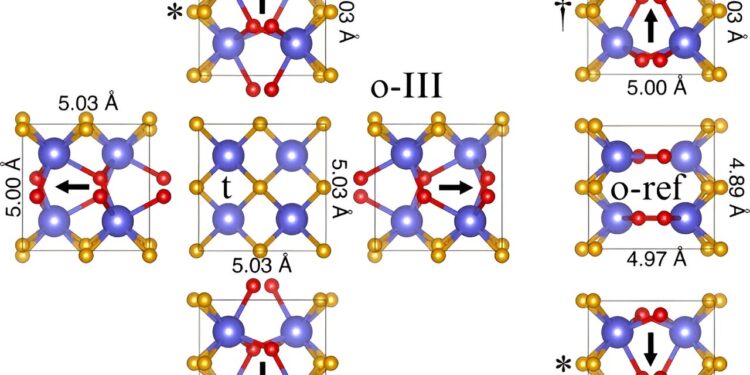
Ferroelectric fields expected in Hafnia. a) shows the tetragonal
Hafnia ferroelectrics are based on their technical promises and their remarkable behaviors, whose particularities come from an active extrinsic mechanism which contributes to their properties from an increasing number of new intrinsic characteristics.
Due to their unconventional nature, fundamental questions regarding these materials remain open. In a new report published in Communication media, Hugo Aramberri, Jorge Iniguez and a team of researchers in materials research, science and physics in Luxembourg, used first-principle simulations to show how the adoption of an original high-symmetry reference phase led to the development of ‘a mathematically simple and physically transparent system. treatment of the ferroelectric state of Hafnia. The work provided deeper insights into Hafnia ferroelectrics to optimize their properties and induce new properties.
Ferroelectrics and reasons for an alternative approach to hafnia
Hafnia ferroelectrics are technically very promising and have surprising properties due to their nanostructures and tunable piezoelectric response. The behavior of such materials remains to be understood; however, a majority of intrinsic and extrinsic factors influence the observed properties. These include the intrinsic characteristics of perfect crystals.
Based on first-principles simulations, Aramberri and his team showed the existence of a ferroelectric state and revealed its properties. Ferroelectricity in Hafnia shows the ferroelectric phase with four different domains in Hafnia samples.
During the awakening cycle, hafnia behaves as a biaxial ferroelastic material which requires a theory based on a high symmetry tetragonal reference structure. The “awakened” hafnia and zirconia samples exhibit coexistence of phases, including the o-III ferroelastic state, the well-known monoclinic ground state, and other orthorhombic polymorphs. These polymorphs are separated by zero-width boundaries.
Energy landscape connecting the HfO key2 polymorphic. The black lines show the calculated energy variation between phases t and o-III (a), o-III and o-ref (b), and o-ref and m (c). Energies are calculated for intermediate structures obtained by linear interpolation between the corresponding endpoint polymorphs. The red line in (b) shows the energy variation of the o-ref state during the condensation of the distortions present in the o-III phase; the red line in (c) shows the analogous result considering only the phonon distortions present in the m phase. The blue line in (c) shows the result of the condensation of the phonon and shear strain distortions present in the m phase, while the green line shows the energy change associated with shear alone. In (b) and (c), the additional distortions leading to the black line are fully symmetric modes, including normal cell stems. Credit: Communication mediadoi:10.1038/s43246-023-00421-z
The nature of Hafnia’s ferroelectricity
Hafnia exhibited typical ferroelectric characteristics with large coercive fields and polar-order resilience at the nanoscale. The researchers had previously noted a strong dielectric anomaly in which heating hafnia resulted in a ferroelectric phase transition, much like suitable ferroelectrics such as high-permissivity barium titanate.
Density functional theory simulations of barium titanium oxide exhibited features characteristic of ferroelectricity. The results also shed light on possible transitions between stable polymorphs of Hafnia and variations in its structural details.
To study ferroelectric switching and field-induced transitions in hafnia and zirconia, Aramberri and his team constructed a theoretical reference state o as a starting point to facilitate reference of all relevant intermediate states.
During the experiments, the team conducted studies using first principles of density functional theory and calculated polarization using modern polarization theory. For symmetry analysis, they used standard web-based crystallographic tools and visualized the structural representations of the structures using X-ray diffraction patterns.

Phonon bands of the o-ref phase. a shows the calculated bands, presenting the imaginary frequencies as negative values. The most important unstable modes are marked in (a). We also show the corresponding eigenmodes and the polymorphs to which they lead: the soft mode (b) and the corresponding o-III phase (c); the soft mode (d) and the corresponding oI phase (e); the soft mode (f) and the associated m phase (g); and the gentle mode (h) and the corresponding oI* phase (i). We mark in red the active oxygens whose movements characterize these phonons. For polymorphs we report the energy relative to o-ref. Credit: Communication mediadoi:10.1038/s43246-023-00421-z
Outlook
In this way, Hugo Aramberri, Jorge Iniguez and their team introduced a theoretical framework to model the functional properties of the most common ferroelectric phase of hafnia and zirconia, which included switching, field-induced transitions and electromechanical responses.
The team relied on a uniaxial ferroic order that affected many such samples. The scientists discussed the impact of the phenomenon on different treatments, where the results provided a simple but comprehensive picture of the relevant energy landscape of hafnia and zirconia that naturally connect all low-energy polymorphs.
The proposed reference is an ideal starting point, from theoretical and computational studies to the design of new experiments and their optimization.
More information:
Hugo Aramberri et al, Theoretical approach to ferroelectricity in hafnia and associated materials, Communication media (2023). DOI: 10.1038/s43246-023-00421-z
© 2023 Science X Network
Quote: A theoretical approach to ferroelectricity in hafnia-related materials (November 30, 2023) retrieved December 1, 2023 from
This document is subject to copyright. Except for fair use for private study or research purposes, no part may be reproduced without written permission. The content is provided for information only.



